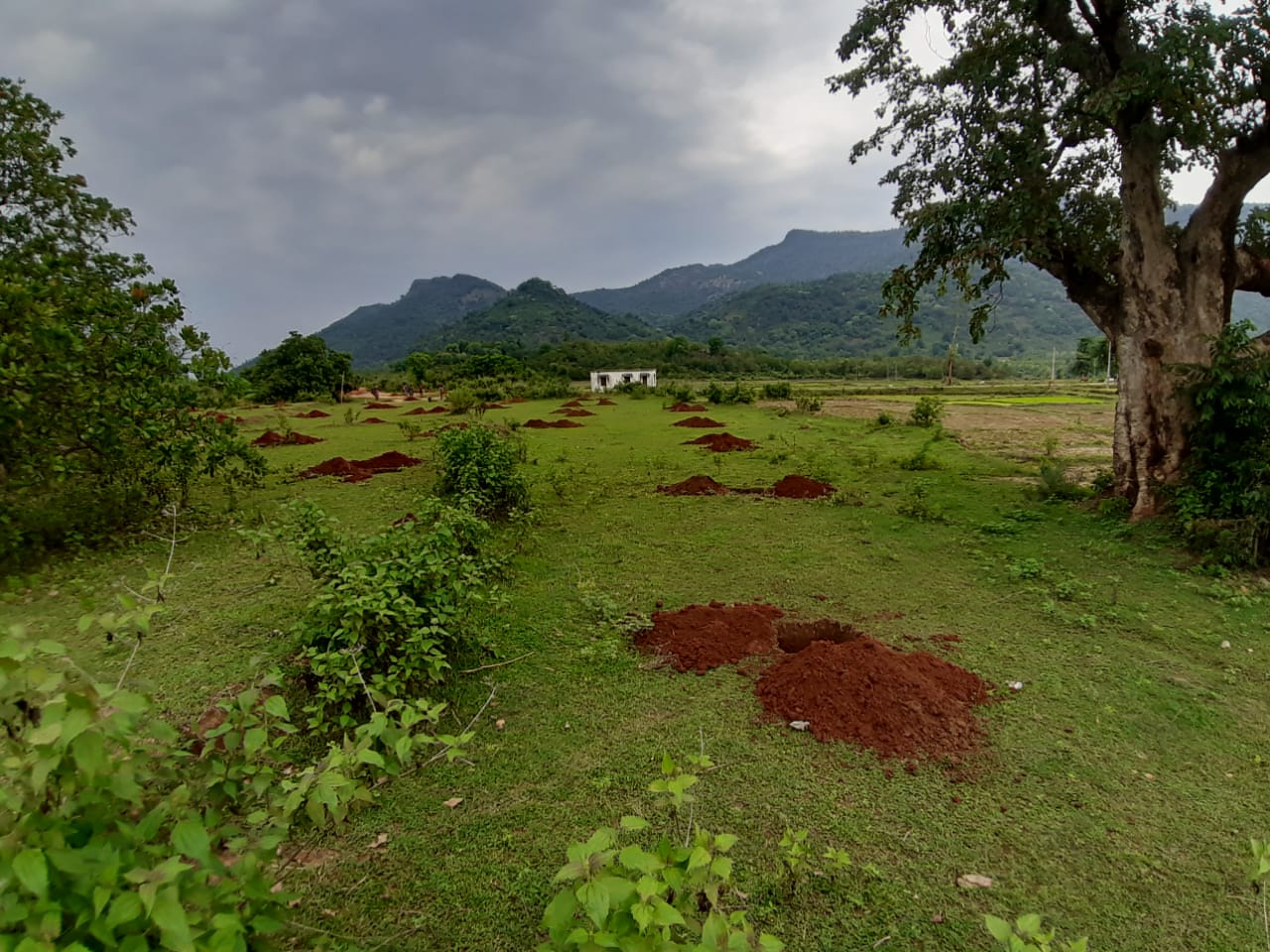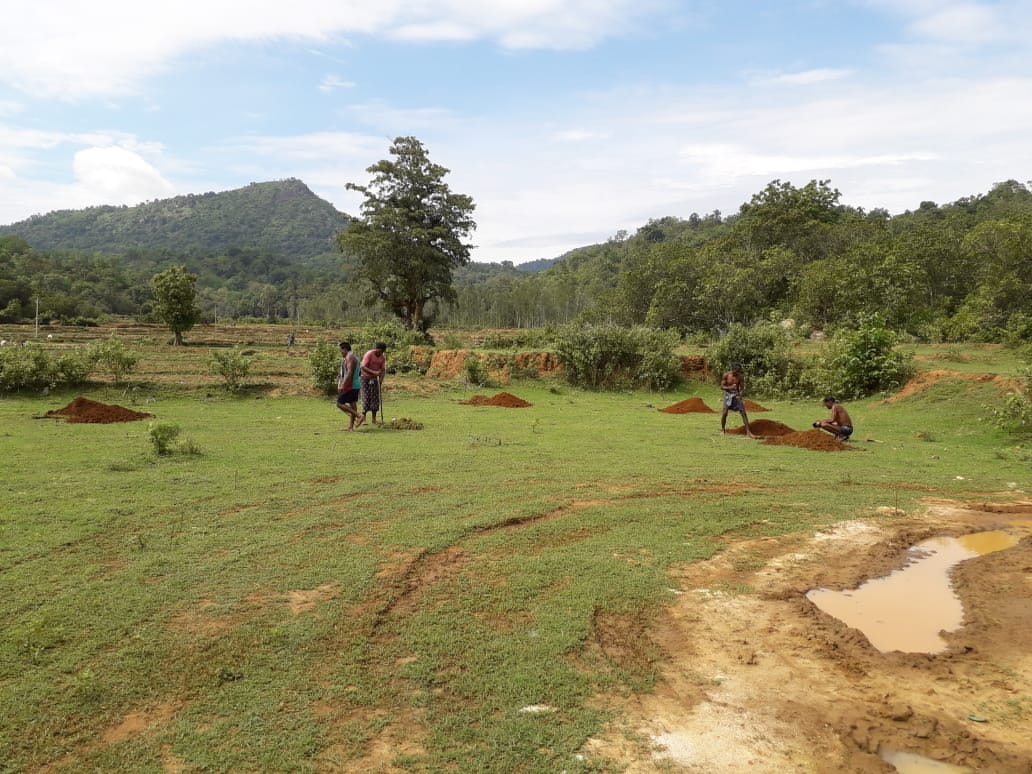As WOTR’s plantation activity gets underway in Odisha, here is a closer look at the process behind readying the land for planting cashew saplings, which will ensure a steady income for smallholder farmers in the longterm.
by Anshuman Panda

Agro-horticulture plantation is usually done in valleys of a watershed where the soil is not suitable for agriculture due to the geography – slopes, rocks or other formidable features of the terrain. It is also done in fallow land where irrigation facilities are almost non-existent.
A horticulture plantation requires minimal irrigation to survive in its initial years – the first year to the third. After the third year, the plantation doesn’t require irrigation as the roots are capable of providing water for photosynthesis. The roots will run deep enough to draw water from the subsoil.

Watershed Organisation Trust’s plantation programme in a specific watershed kick starts with Village Development Committee meetings, where the farmers involved in the plantation are identified.
Thereafter, the site where the plantation is to be raised is visited by the Wasundhara Sevak and other WOTR field staff, to analyse the feasibility leading to subsequent finalisation. This exercise is carried out in the month of May.
Once the land is identified, the layout of the pits to be dug for planting the saplings is prepared. Soon after, the pits are dug. This activity would usually occur around June 15 every year.
In a cashew plantation, the size of each pit is 0.6m x 0.6m x 0.6 metre and the distance of each pit from the next on either side is seven metres. While digging the pit, one has to keep in mind that the soil excavated from top 0.3 metre depth of the pit and the soil excavated from 0.3 metre from the bottom has to be kept separately.
After excavations, the pits are left open for a month. Microbes in the soil that may be harmful for the saplings die when exposed to sunlight. As the soil dries up the pit is filled back again.
The excavated soil is mixed with dry cow dung which will provide multi-nutrients for the saplings. Neem cakes are used as an anti-termite protection. The excavated topsoil will be used first and the soil from the bottom is filled last, so that the fertile soil goes to the bottom of the pit. This will ensure sapling roots enjoy the fertile soil and remain healthy. The pits are then marked with twigs inserted in the middle.

In the next step, grafted cashew saplings – often the V4 variety in south Odisha – are planted after removing a bit of the topsoil. Also, about 10 small holes are made around the pit to form a rough circle. In the holes, another dose of anti-termite formulation is mixed with water and poured in.
Saplings are provided support with a small wooden stick. This is called staking. One has to take into account that the stick should not touch the plant. Instead, the plant has to be supported by a thread tied to the stick. This, too, is an anti-termite measure.
In the winter months, weeding is done. The base of the sapling is covered using uprooted grass along with some straw so as to retain moisture. Along with this, the land is fenced off as domestic and stray animals may consume or destroy the saplings.
During summer, the land is irrigated every week to sustain the growing trees through the season.
This process is followed for three years. Along with mulching and weeding, pruning needs to be done as well. Pruning is the process in which extending branches of the young trees are cut for new leaves to sprout. This is beneficial in the longterm. If young trees flower within the three-year period, they need to be plucked. The tree is very small and not yet ready to hold the weight of fruits.
How farmers are chosen

For a farmer to be selected for the plantation activity, s/he needs to have a minimum of 0.4 hectare of land. A total of 80 saplings are planted. The cost per pit is Rs 30. The cost of fencing for the patch is Rs 5,000. This is provided as input support along with the grafts, neem cakes and tree guards. Land preparation, irrigation and intercultural activity are the farmer’s responsibility.
As the old saying goes, trees are like children. If you take care of them they will take care of you in the long run. After three years, the trees will start fruiting and benefit the farmers.
On an average, in WOTR’s operational area in Gunupur, the plantation done by government yields Rs 40,000 from 0.4 hectare of land.
Agro-horticulture in Gunupur Cluster, Odisha

| Agro-horticulure plantation (Cashew) 2019-20 | ||||||
| Name of the beneficiary | Village | Area (Ha) | Saplings Planted | Saplings
Standing |
Survival rate | |
| 1 | Surendra Gamango | Tarda | 0.8 | 160 | 152 | 95.00% |
| 2 | Pedra Gamango | Udap Garjang | 0.4 | 80 | 77 | 96.25% |
| 3 | Abini Gamango | Udap Garjang | 0.4 | 80 | 72 | 90.00% |
| 4 | Marry Sabar | T.Targising | 0.4 | 80 | 75 | 93.75% |
| 5 | Prakas Sabar | T.Targising | 0.4 | 80 | 73 | 91.25% |
| 6 | Hemant Sabar | J.Targising | 0.4 | 80 | 71 | 88.75% |
| 7 | Pitas Karji | Dengini Garjang | 0.8 | 160 | 143 | 89.38% |
| 8 | Surani Mandal | Dengini Garjang | 0.4 | 80 | 66 | 82.50% |
| Total: | 4 | 800 | 729 | |||
Agro-horticulture plantation (Cashew) 2020-21
|
Village |
Farmers | Area (Ha) |
Saplings to be provided |
|
| 1 | Dengeni Garjang | 2 | 0.8 | 160 |
| 2 | Udap Garjang | 7 | 2.8 | 560 |
| 3 | Tarda | 1 | 0.4 | 80 |
| 4 | Kadasi | 5 | 2 | 400 |
| 6 | T.Targising | 2 | 0.8 | 160 |
| 7 | Jaltar | 1 | 0.4 | 80 |
| Total | 18 | 7.2 | 1440 |





